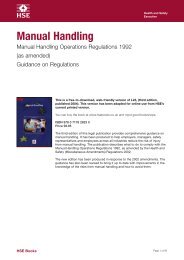Making Companies Safe - what works? (CCA ... - Unite the Union
Making Companies Safe - what works? (CCA ... - Unite the Union
Making Companies Safe - what works? (CCA ... - Unite the Union
You also want an ePaper? Increase the reach of your titles
YUMPU automatically turns print PDFs into web optimized ePapers that Google loves.
management of ‘core business’. They do not appear to believe that <strong>the</strong> one reflects on <strong>the</strong><br />
o<strong>the</strong>r, and are more concerned with senior managers’ ability to effectively manage <strong>the</strong> crisis.<br />
Therefore major disasters – even those involving loss of life – do not necessarily have<br />
long-term (or even medium-term) negative impacts on shareholder confidence, and in some<br />
cases actually offer senior managers an opportunity to enhance <strong>the</strong>ir reputations in <strong>the</strong> eyes<br />
of shareholders. Following Hopkins (see above), it is clear that we also need to ask in relation<br />
to reputational damage: ‘for whom does safety pay’? These cases show that senior decision<br />
makers do not necessarily suffer reputational damage following a major catastrophe and may<br />
even benefit from it. Interestingly, Knight and Pretty class <strong>Union</strong> Carbide as a ‘non-recoverer’<br />
six months after <strong>the</strong> Bhopal disaster. However, as we have seen, senior management<br />
benefited from <strong>the</strong> disaster in monetary terms, despite <strong>the</strong> loss of shareholder value (see<br />
above). So even when <strong>the</strong>re is a negative shareholder reaction, <strong>the</strong>re is no guarantee that<br />
management will be affected by this.<br />
Customer and Supply Chain Pressure (4): Here again, <strong>the</strong> evidence suggests that customers<br />
rarely exert a positive pressure on employers to improve <strong>the</strong>ir OHS performance. Only 1% of<br />
respondents cited customer pressure as a main prompt for improvements in a recent survey<br />
of 1,902 organisations in <strong>the</strong> UK. 38 Similarly, Brazabon et al. report that:<br />
“Pressure from stakeholders to improve health and safety is considered to be<br />
relatively low for most [construction] companies.” 39<br />
And Smallman and John report that:<br />
“Customer influence is not a direct source of pressure for improvements in health<br />
and safety management.” 40<br />
Whilst <strong>the</strong>re has been some consumer pressure exerted on brand name companies in relation<br />
to working practices and conditions within subsidiary companies or amongst <strong>the</strong>ir suppliers, 41<br />
<strong>the</strong>se consumer campaigns have not tended to address working conditions or health and<br />
safety practices within companies located in <strong>the</strong> UK. Consumer awareness and concern about<br />
corporate health and safety performance is really only likely to become an issue within a<br />
limited range of contexts – for example in sectors where services may pose a risk to public<br />
safety, such as <strong>the</strong> rail, road or air transport industries. And even here, <strong>the</strong> extent to which<br />
consumers or customers can directly impact on business activities will be fur<strong>the</strong>r limited in<br />
relation to public sector or monopoly operators. Wright points out that in <strong>the</strong>se contexts any<br />
negative impacts on business will be dependent upon regulator intervention. 42<br />
Wright also points out that <strong>the</strong> extent to which ‘stakeholders’ can exert customer or supply<br />
chain pressure by withdrawing <strong>the</strong>ir demand for a particular service will be circumscribed if<br />
supply of and demand for a service are ‘inelastic’. For example, supply of a service may<br />
be inelastic if <strong>the</strong> service depends on a large, costly infrastructure that takes long periods<br />
to construct, such as rail services, or services that are difficult to substitute such as law<br />
enforcement services. 43 Here again, stakeholders will depend upon regulator or direct<br />
government intervention to impact upon <strong>the</strong> business. In inelastic markets, services cannot be<br />
readily substituted, but regulator and government action can never<strong>the</strong>less impact on business<br />
through, for instance, <strong>the</strong> imposition of additional costs (by introducing new regulations or<br />
imposing additional safety requirements), or through restrictions on operational/commercial<br />
freedom. 44<br />
In relation specifically to supply chain pressure, <strong>the</strong>re is no evidence that it currently acts<br />
as a general driver for improved OHS performance amongst employers. 45 For instance, no<br />
respondents to <strong>the</strong> survey referred to above cited competitor pressure as a factor motivating<br />
improved OHS performance, 46 and a study of health and safety in <strong>the</strong> construction industry<br />
reported that interviewees considered that <strong>the</strong> health and safety practices of competitors<br />
had <strong>the</strong> least influence over health and safety out of a number of possible influences. 47<br />
This evidence suggests that, in general, employers do not believe that having a better health<br />
and safety record than <strong>the</strong>ir competitors will put <strong>the</strong>m at an advantage in winning work, and<br />
this is consistent with Smallman and John’s 48 finding that even amongst large firms, British<br />
directors do not believe that good OHS performance gives firms a competitive advantage.<br />
In fact, <strong>the</strong>re is some evidence that supply chain pressure can, and in certain sectors commonly 75
















